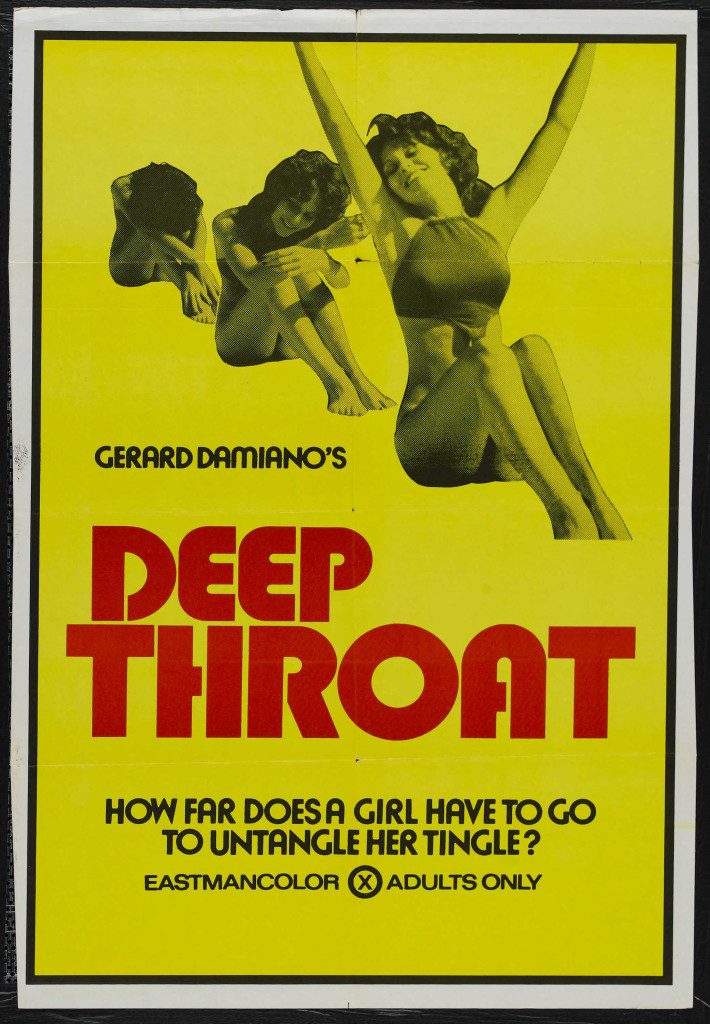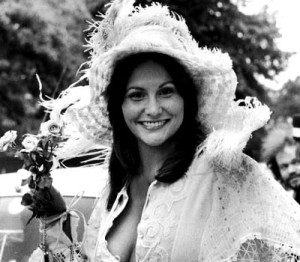***
I first met Dylan Ryan at a reading I put together in the East Village. She was tall, tough, and fierce. But she also had a sly, funny twinkle in her eyes. She looked like she could kick my ass, but would prefer to make me laugh.
This proved to be an accurate assessment. Dylan bills herself as “the Gary Oldman of porn,” and it’s an apt descriptor. She is the thinking man’s (and woman’s) porn star. She defies category. And she’s very good at what she does.
I pursued Dylan to get some writing for Johns, Marks, Tricks and Chickenhawks, an anthology I edited (and excerpts of which have appeared on The Rumpus). As we worked on the piece, the more I got to know her, the more I realized she had a lot on her mind. So I thought I would check in with her after I saw the movie Lovelace, and see what she had to say about the film, the sex business, and life in general.
***
The Rumpus: In the movie Lovelace, Linda Boreman was forced into the pornography business by her abusive husband. How did you get started in porn, and how did you react when you saw how Linda got into the business?
Dylan Ryan: I started to write, and then erased and started over with these interview answers about twenty times, before realizing that I just needed to write the initial thought I kept leaving off: this movie made me very, very sad. And what made me even sadder, still, was the fact that the movie was likely intentionally designed to make me sad.
The movie begins (spoiler alert for anyone who hasn’t seen it) with a carefree and somewhat prudish young Linda being frightened of and mildly repulsed by sexuality, and fast-tracks into her relationship with Chuck Traynor, whom she marries and with whom she enters into the world of pornography. We see images of their happy sexytime, her happiness on set, her smiling onstage when she becomes famous. We feel like we are waiting for the other shoe to drop but, regardless of that feeling, are still so happy that she seems happy. I, not knowing the whole Linda Lovelace story prior to watching, was duped into thinking that this would be a story of later shame-based, social stigmatizing regrets. Little did I know until—boom! We are dunked in the cold water tank, the softball of storytelling hitting us square on the target, as we find out that Linda has been abused, gang-raped, coerced, and forcibly prostituted into a life of victimhood and forced performative sex. No way could she have made all those decisions herself—any belief we had in her own agency is ripped from our minds, as we are shown how naïve that possibility could be.
 By leaving all the gory and violent details until the last part of the movie, the director and screenwriter heavily reinforce the narrative with which we are all so familiar: women in porn are victims. There is no happiness there. There is no choice, there is only shame and degradation. Only by finishing the movie with Linda getting out (with the help of other big, bad men, by the way) of her relationship with Chuck Traynor, and marrying another, somewhat nicer-seeming man, do we feel like Linda has a shot at life. Her story is structured around the various men in her life, bad, good, and indifferent. And there is no retribution for her in being supported for her choices—only moving on by disowning an entire part of her life. She can only be accepted back into society by disowning Linda Lovelace.
By leaving all the gory and violent details until the last part of the movie, the director and screenwriter heavily reinforce the narrative with which we are all so familiar: women in porn are victims. There is no happiness there. There is no choice, there is only shame and degradation. Only by finishing the movie with Linda getting out (with the help of other big, bad men, by the way) of her relationship with Chuck Traynor, and marrying another, somewhat nicer-seeming man, do we feel like Linda has a shot at life. Her story is structured around the various men in her life, bad, good, and indifferent. And there is no retribution for her in being supported for her choices—only moving on by disowning an entire part of her life. She can only be accepted back into society by disowning Linda Lovelace.
Is it her story? Yes. Is it based on the memoir she wrote about her abuse—abuse that really happened? Did the story need to be told the way it was, capitalizing on the horrors rather than reinforcing the identity of the woman who lived through them? No. This seems to me just another abused-woman-in-porn story. And I find it sad, because even though it was true and even though that has happened and continues to happen, do we need more of those stories? Do we need to sensationalize those stories? No.
I am not Linda Lovelace. I was not coerced into porn. I began in the industry almost ten years ago, when a good friend, who had long talked of starting her own porn company, gave me an opportunity to perform in her first film. Having done some erotic photography and worked at a peep show for a few years, I was curious about what it would be like to perform in front of a camera, and felt positive about doing this for a woman-owned company that was interested in showcasing my authentic sexuality. It was a wholly positive experience and one that ushered me into the world of performing on a more regular basis.
My time in the industry has definitely been marked by ups and downs, much the way any job would be. The main difference between my story and Linda’s is not just that I wasn’t abused and forced to perform, but also that I always made my own choices. Even when I would have a bad day at the office (bad days on porn sets can be mighty uncomfortable), I still wanted to be there and I always felt and knew that I could leave. I get so sad when I hear more negative porn stories, not only for the person who experienced such a tragic and difficult existence, but for the people who will add it to their already-negative perceptions of porn and women in porn, and not ever imagine that there could be another way, that it could be a choice, that the women who perform could be there because they want to be, because they choose to and because they feel good about it.
Rumpus: In the ‘70s, Linda Lovelace became a huge star, but she was also the punch line to countless slut-shaming jokes. She was rejected and shunned by her family. Have you been the subject of shaming as a result of being in porn?
Ryan: This is always an interesting question for me because it’s both a yes and no question. Have I experienced slut-shaming because I make porn? Yes. But the thing is, I haven’t experienced it directly. So not exactly.
I have experienced the world’s general moral disdain for sexually promiscuous choices and aspects of sexuality that fall outside of the norm, and I have definitely experienced an amorphous social concern about women in porn that often translates into statements that vacillate between perverse curiosity and outright disgust. But the thing about those experiences is that they are all general: things I see on TV, read in mainstream media, overhear in conversations… These are things not being said to my face. I have been very lucky that all my face-to-face interactions have been primarily positive, supportive—people are intrigued without being intrusive. I think I have been both calculated and, again, lucky in the fact that I present an educated, empowered face and that’s harder for people to confront, harder for people to tear down. Also, I’m tall and Caucasian, so that helps; my privilege is a protector, to some extent.
 When it comes to my intimates, people in my close world, everyone is super-supportive. I have cultivated relationships that allow me to talk about my world without shame, without fear, and with the casual banter style that most friendly conversation is afforded. I get to hang out and chat about being tied up and flogged the way most people discuss a trip to the grocery store. And that’s pretty fabulous. Porn has, at various intervals, been hard on my partnered relationships, and while I spent a great many years thinking about whether or not I had better leave the business to save my relationship, I ultimately realized that that person’s thinking I was a slut had a lot more to do with their stuff and far less to do with the stuff I was doing, and that has informed my sense of self and future relationships.
When it comes to my intimates, people in my close world, everyone is super-supportive. I have cultivated relationships that allow me to talk about my world without shame, without fear, and with the casual banter style that most friendly conversation is afforded. I get to hang out and chat about being tied up and flogged the way most people discuss a trip to the grocery store. And that’s pretty fabulous. Porn has, at various intervals, been hard on my partnered relationships, and while I spent a great many years thinking about whether or not I had better leave the business to save my relationship, I ultimately realized that that person’s thinking I was a slut had a lot more to do with their stuff and far less to do with the stuff I was doing, and that has informed my sense of self and future relationships.
I have found that when I know my own boundaries, when I have confidence in me, other people do, as well, and I’m also far better at blowing off any random a-hole that wants to pass judgment on me. Not in my life? Not one of my chosen people? I don’t care what you have to say about my choices.
Rumpus: How do you think pornography has changed since Deep Throat? How do you think the world’s reaction to porn has changed?
Ryan: I think the world of porn has changed a lot since Deep Throat, in both positive and negative ways. I think there is a lot more porn than there used to be, and so, consequently, there are better representations of sexuality than there used to be and [it is] much more likely that each person will be able to find their personal turn-on or sexual ice cream. There are also one hundred more ways to objectify and pervert images of women, transpeople, and people of color. There is much more porn that is made with women in mind and much more porn that is focused on sex education. There are also one hundred more ways for people to get their porn and hundreds of additional ways for kids to see it and, without proper support, think that that’s what sex is supposed to be, without the necessary context. Porn has gotten even more fun and silly and awesome. It’s also gotten more trivial and focused on things like big boobs and hairlessness and huge penises (though there were some huge ones in the ‘70s) and fake sounds and an unrealistic standard of beauty. Porn has developed into so many genres and been explored as art, performance, research, communication; porn now has Porn Studies, has its own journal, has been looked at almost every which way you can look at it. Porn has also continued to be the thing we go to when we just need to get off.
Our relationships to porn remain complicated and incredibly simple. Porn has proliferated and taken so many hits. It prevails and continues to be one of the many pop culture meters that is both affected by what people want and determines what people want. It is the ultimate representation of human sexuality and the biggest way in which we incorrectly interpret human sexuality. Porn is us.
Rumpus: Linda Boreman says she felt debased by pornography. Do you feel empowered or disenfranchised by being an adult film performer?
 Ryan: More often than not, I feel empowered by being an adult performer. I know my experience is not true for all performers, but porn has been primarily confidence-building, educational, and developmental. I have definitely had some bad days and I have left sets feeling less-than and like I didn’t stay true to myself. But by and large, I feel more debased by the outside world than I do by porn.
Ryan: More often than not, I feel empowered by being an adult performer. I know my experience is not true for all performers, but porn has been primarily confidence-building, educational, and developmental. I have definitely had some bad days and I have left sets feeling less-than and like I didn’t stay true to myself. But by and large, I feel more debased by the outside world than I do by porn.
In porn, I feel in control of my own sexual representation. Out in the world, I feel often out of control when it comes to being ogled, harassed, and debased. On set, I feel respected and self-aware. In the outside world, I feel like a piece of meat far more often than when I am working. And this is not because people know I do porn, but because out in the greater world, women are available for harassment. Just riding the bus to work, I feel more debased than when I am naked and having sex for the camera. I have found that people who engage with my work are mostly respectful and thoughtful, but the average joe on the street thinks that just because I’m wearing a skirt, he can cat-call me and try to grab me. Porn is a much more considerate place than people give it credit for being sometimes. It’s all a matter of perspective.
Rumpus: Deep Throat became a date movie for couples and was listed in Variety as a top-fifty grossing movie for many weeks. Can you imagine any of your films sitting on that list next to The Hunger Games?
Ryan: I would love that. I would love it if we lived in a world that was open enough about sexuality and supportive enough of representations of sexuality—especially women’s sexuality—to show porn, especially queer porn, in a mainstream context. When I learned that Lovelace was shown that way, I was pretty astounded and found myself wondering how things had changed from that type of conventional movie-watching of porn, to porn being shown only at spank houses, to not really being shown at public movie theaters at all. Currently there are some fabulous erotic film festivals internationally that provide for that shared erotic film-watching experience, and I think they not only fill a niche, but provide a necessary social experience: that of watching erotic content out in the open, with others, without the overtones of shame and degradation. It can also just be great fun to sit in a huge theater, watching hot sex and listening to the sounds of the people around you; their “ooohs” and “ahhhs” and giggles and grunts.
Rumpus: In Lovelace, pornography is portrayed as a completely male-dominated industry. Do you still feel it is?
Ryan: For the most part, yes. Though I would not say completely any longer. Mostly yes, but not completely, and I will tell you why. Women like Tristan Taormino, Nina Hartley, Annie Sprinkle, Courtney Trouble, Jessica Drake, Candida Royale—don’t know these names? Google them and enjoy the awesomeness—have changed the industry into a place where women are more wholly represented, whilst simultaneously expanding and reinforcing the genre of feminist porn, a genre that was not really around in the ’70s. Now does feminist porn make as much money as mainstream porn created by men for male viewers? No. But! It is changing what is available, what people have access to, how women feel about porn, how people interact with their porn, and how porn performers are treated both on and off set. These women are the reason it is “mostly” but no longer “completely.” And they rule.
Rumpus: Deep Throat reportedly grossed $600 million and Linda Boreman was paid $1,250. How does that make you feel? How do you make sure you get paid what you’re worth?
Ryan: I think I feel differently than people imagine I would feel. I think people imagine that I would be up in arms about the discrepancy, but I actually feel like $1,250 is a lot of money, especially for that time. It is a lot more than many women make even now for the same type of work. I do think it would have been ideal if Linda had been able to get a chunk of the revenue from the film, but that’s such a rare occurrence in the world of porn.
 Performers charge per scene and they have a rate based on the sex acts that will be performed and the time spent on set. It is also impacted by how big a name the performer is and how much they can command. It can vary based on circumstances and the situation, but it is usually pretty set and very rarely does it include any compensation after the day of shooting. The rate that Linda got (though I don’t know what all that money included) is on the reasonable side for a full day of shooting with male talent—beyond one day is when she would have been shorted.
Performers charge per scene and they have a rate based on the sex acts that will be performed and the time spent on set. It is also impacted by how big a name the performer is and how much they can command. It can vary based on circumstances and the situation, but it is usually pretty set and very rarely does it include any compensation after the day of shooting. The rate that Linda got (though I don’t know what all that money included) is on the reasonable side for a full day of shooting with male talent—beyond one day is when she would have been shorted.
I definitely always think that porn performers should be paid more, but I have the sex worker perspective that colors my understanding, as well. Porn is at the top of the sex worker pay scale, it is the “caviar” of sex work according to many sex workers themselves. A good majority of sex workers perform the same sex acts as porn performers for one-tenth the money and many times the risk. Consequently, I think porn money is often a lot of money. Rightly so, but nonetheless decent compensation. And yes, after all these years, I get paid what I’m worth. I take jobs that pay my rate and I get to work with people that respect me enough to compensate me. I know that’s not the way of it for everyone, and so it feels even more important to me that set rates be paid to performers so that a standard is maintained.
Rumpus: What did you take away from Lovelace?
Ryan: Once I got past feeling so sad and needing a hug from my partner, I took away what I always take away from anything I read or watch or hear about porn: that the most important thing I can do in this industry is me. That it’s ultimately not about who I am doing, but if I am doing me. Am I representing myself and what I want? Showing how I like to have sex? Am I comfortable, empowered, happy? Am I where I want to be, doing what I want to be doing? Those questions have to stay at the center of my work because I have now, as I have always had, a responsibility to diversify porn, to show a woman who loves to have sex, doing what she wants to be doing. I have this responsibility to women, to men, to queers, to Linda Lovelace. She didn’t get a choice until the very end. And her story has added to the canon of stories of victimization, abuse, and violence. I want my story to go in the small pile of happy ones until there are enough in there to be their own canon of positivity. I want my story to be out there for women who love sex but are ashamed. Women who want to talk about sex but are shy. Women who have desires and needs and interests and don’t see themselves in the stories of debasement and coercion. The women that are looking for my story, I want them to find it.
That is my takeaway. If I could meet Linda Lovelace, I would thank her for what she went through. Whether she wants to own it or not, her story has impacted my own and it spurs me on.
***
First image of Dylan Ryan © by Courtney Trouble.
Second image of Dylan Ryan © by Joshua Darling.




